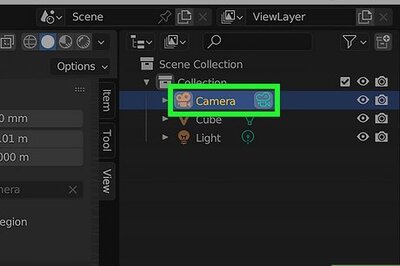
views
Check your internet connection.
Check your Wi-Fi connection. Check the Wi-Fi icon in the upper-right corner on your phone and Mac computer, or in the lower-right corner on Windows and Chromebook. It resembles arching lines over a dot. The more lines you have, the better your internet connection. Make sure you have a good internet connection. If other apps or devices are running slowly or not loading, this could be a sign that you have an unstable internet connection. If your internet connection is running slowly, try restarting your router. Unplug it for 30 seconds and then plug it back in. If you are connected to public Wi-Fi, you may need to sign in or agree to the terms of service. Open your web browser to see if there is anything else you need to do to connect.
Make sure Airplane Mode is turned off.
Airplane mode prevents you from connecting to Wi-Fi. If you've accidentally turned Airplane Mode on, your device will not be able to connect to the internet or refresh your email. Use one of the following steps to check and make sure Airplane Mode is turned off: Android: Swipe down from the top of the screen to open the Quick Access menu. If the icon that resembles an airplane is highlighted, tap it to turn it off. iPhone & iPad: Swipe down from the upper-right corner of the screen to open the Control Center. If the airplane icon is highlighted, tap it to turn it off. Windows: Click the Wi-Fi icon in the lower-right corner of the taskbar. If the airplane icon is highlighted, click it to turn it off. Mac: Mac doesn't have a designated airplane mode. Make sure your Wi-Fi is connected. Chromebook: Chromebook doesn't have a designated airplane mode. Make sure you are connected to Wi-Fi.
Check your cellular data settings.
Your cellular data settings may restrict your email. If you are not receiving emails while using cellular data, you may have low data, or data saver mode on. This mode is to limit the amount of data you use while using cellular data so that you don't receive excessive data charges. Use one of the following steps to check your cellular data settings: Android: Swipe down from the top of the screen to open the Quick Access menu. Tap the Gear icon to open the Settings menu. Tap Connections (Samsung Galaxy) or Internet & Network (stock Android). Tap Data usage (Samsung Galaxy only). Tap Data Saver. Ensure Data Saver is turned off. Additionally, tap Unrestricted Data or Apps that can always use data and make sure your email app is always allowed to use cellular data. iPhone & iPad: Open the Settings app and tap Mobile data or Cellular data. Tap Mobile data options or Cellular data options. Ensure Low Data Mode is turned off. Additionally, you can scroll down and find your email app. Ensure the toggle switch next to it is turned off.
Ensure Background App Refresh is turned on.
Background App Refresh may be disabled. Background App Refresh allows apps on your mobile device to update in the background. If it's disabled, your email app may not refresh in the background. Use the following steps to make sure Back App Refresh is turned on: Android: Swipe down from the top of the screen to open the Quick Access menu. Tap the Gear icon to open the Settings menu. Tap Apps (or Apps & notifications). Tap All apps. Tap your email app and tap Mobile data. Ensure the toggle switch next to "Allow background data usage" is turned on. iPhone & iPad: Open the Settings app and tap General. Tap Background App Refresh. Ensure Background App Refresh is turned on.
Restart your device.
There is a minor glitch in your device. Restarting your device can fix many minor glitches. Use one of the following steps to restart your device: Android: Press and hold the Power button until the Power menu appears. Tap Restart or Reboot. iPhone & iPad: Press and hold the Power button and either volume button until the power slider screen appears. Drag the slider to power off your iPhone. Wait 30 seconds and press the power button to turn it back on. Windows: Click the Windows Start button and click the Power icon, which resembles a circle with a line through it. Then click Restart Mac: Click the Apple icon in the menu bar. Then click Restart. Chromebook: Click the time in the lower-right corner. Click the power icon, which resembles a circle with a line through it. Then click Restart.
Update your email app.
Your app may be outdated. If it is outdated, it may have bugs and security flaws that need to be fixed. If it is outdated enough, it may not connect to the server. You can update apps in the Google Play Store on Android devices, or the [Update-Apps-on-an-iPad|App Store]] on iPhone and iPad. If you're using Gmail on a desktop computer, you don't need to update anything since Gmail is a web-based application. To update Outlook on Windows, click File > Account or Office Account > Update Options > Update Now. To update Apple Mail on a Mac, you will need to update macOS.
Update your device.
Your operating system may be outdated. In addition to updating your email app, you may want to try updating your entire operating system. This will patch out any security risks as well as fix any known flaws. Use one of the following steps to update your device: Android: Swipe down from the top of the screen and tap the gear icon to open the Settings menu. Tap Software Update (it may be under System). Follow the on-screen prompts to update your device. iPhone & iPad: Open the Settings app. Then tap General followed by Software Update. Tap Install Now or Download and Install. Windows: Click the Windows Start menu. Then open the Settings menu. Click Update & Security (Windows 10 only) and click Windows Update. Click Check for Updates. Click Install all. Mac: Click the Apple icon in the menu bar and click System Settings or System Preferences. Click General. Then click Software Update. Click Update or Upgrade. Chromebook: Click the time in the lower-right corner. Click the Gear icon to open the Settings menu. Click About Chrome OS. Click Check for Updates.
Check your sync settings.
Sync may be turned off. With many email apps, it's possible to turn automatic sync on and off. Use one of the following steps to check your sync settings for your email app: Gmail: Open the Gmail app. Tap the icon with three lines (☰) in the upper-right corner. Scroll down and tap Settings. Tap your Gmail account. Scroll down and ensure the box next to "Gmail Sync" is checked. Apple Mail: Open the Settings app. Tap your name at the top. Tap iCloud. Tap iCloud Mail. Ensure Mail or iCloud Mail is turned on. Apple Mail on Mac: Click the Apple icon in the menu bar. Click System Settings or System Preferences. Click your name. Click iCloud. Ensure iCloud Mail is turned on. Outlook on Mobile: On mobile devices, you just need to make sure you are signed in to the correct account. Tap the profile icon icon in the upper-right corner to see what account you are signed into. To add account, tap Settings at the bottom of the menu. Then tap Accounts followed by Add account. Follow the prompts to sign into an account. Outlook on a computer: Open Outlook and click File. Click Account settings and click Account Settings in the drop-down menu. Select your account and click Change. Click More Settings and click the Advanced tab. Make sure the box next to "Use Cached Exchange Mode" is checked and click Download Shared Folders followed by Ok. Use the slider bar to select how recent you want to sync your emails (i.e. 1 year), and click Next. Then click Finish.
Check your notification settings.
Your email app might not be set to send you notifications. If you are not receiving notifications for your emails, check to make sure your email is allowed to send you notifications. You can adjust your notification settings in the Settings menu on most devices. Use one of the following steps to do so: Android: Swipe down from the top of the screen to open the Quick Access menu. Then tap the Gear icon to open the Settings menu. Tap Notifications. Tap App Notifications. Tap your email app. Ensure that "Allow notifications" is turned on. If you're using Gmail, tap Configure in Gmail and select an account. Ensure the account you selected is set to send email notifications. iPhone & iPad: Open the Settings app and tap Notifications. Tap Mail (or your email application). Ensure "Allow notifications" is turned on. Then tap Custom Notifications and check the notifications settings for individual accounts. Windows: Click the Windows Start menu and click the Gear/Settings icon. Click System followed by Notifications. Ensure notifications from your email app are turned on. Alternatively, you can use Phone Link to link to your phone to your computer and receive your phone notifications on your computer. Mac: Click the Apple icon and click System Settings or System Preferences. Click Notifications. Click Mail or your specific email application or website. Ensure "Allow notifications" is turned on. Web browser: If you check your email in a web browser, you may need to log in to your account and check the settings menu. Make sure you set it to send you desktop notifications. You may also need to check your web browser's site settings and make sure you haven't blocked your email website from sending notifications.
Check your cloud storage space.
You may be running out of online storage space. Gmail, Apple Mail, and Outlook use cloud storage. When you sign up for an account, you get a limited amount of storage space for free. When you run out of storage space, you might not be able to receive any more emails. You will need to delete some files stored in your cloud storage or delete some old emails to free up space. Use one of the following steps to check your cloud storage: Gmail/Google Drive: Open https://drive.google.com/ in a web browser and log in to your Google account. Check how much storage space you have in the menu bar to the left. If your storage space is full, delete some files, or click Get More Storage to upgrade your subscription. Apple Mail/iCloud: Go to https://www.icloud.com/ in a web browser and sign in with your Apple ID. Scroll down and see how much storage you have used below "Storage." If your storage is full, click the iCloud icon in the window that contains your apps. Delete some files to free up space. Alternatively, you can check your iCloud storage in the Settings menu on your iPhone, iPad, or Mac. Click your username at the top of the settings menu and click iCloud. Then click Manage Storage. Outlook/OneDrive: Go to https://www.microsoft.com/en-us/microsoft-365/onedrive/ in a web browser and log in to your Microsoft account. Check how much storage you have used at the bottom of the menu bar on the left. If your storage is full, you will need to delete some files in your OneDrive account. You can also delete files in your OneDrive account using File Explorer on a Windows computer.
Check your device storage.
Your device storage may be full. You need a little bit of free storage on your device to update apps in the background. In general, you should keep at least 3 to 4 GB of storage for various tasks. If your device storage is full, you will need to delete some apps or files. Use one of the following steps to check your device storage: Android: Swipe down from the top of the screen to open the Quick Access menu. Then tap the Gear icon to open the Settings menu. Tap Device care (Samsung Galaxy). Tap Storage. Check how much storage you have available. iPhone & iPad: Open the Settings app. Tap General. Then tap [Device] storage. Check how much storage you have available. Windows: Press Windows Key + E to open File Explorer. Click This PC. Check how much storage you have below your primary drive. Mac: Click the Apple icon in the menu bar and click System Settings or System Preferences. Click General. Click Storage and then click All volumes. Check how much storage you have on your Mac. Chromebook: Click the time in the lower-right corner. Then click the Gear icon to open the Settings. Click Storage Management. Check how much storage you have left.
Delete and reinstall your app.
The app may be corrupt. Deleting and reinstalling an app will clear the cache and user data from the app. This will not delete your emails, but you will need to log back in when you reinstall the app. You can uninstall an app on iPhone and iPad by tapping and holding the app icon on the Home screen. On Android, tap and hold the app icon on the Apps menu. Then tap the option to delete or uninstall the app. Then you can download the app again from the Google Play Store on Android, or the App Store on iPhone and iPad. To uninstall Mail on an iPhone, open the Settings app and tapping General. Then tap iPhone/iPad Storage. Tap the Mail app and tap Delete App.



















Comments
0 comment